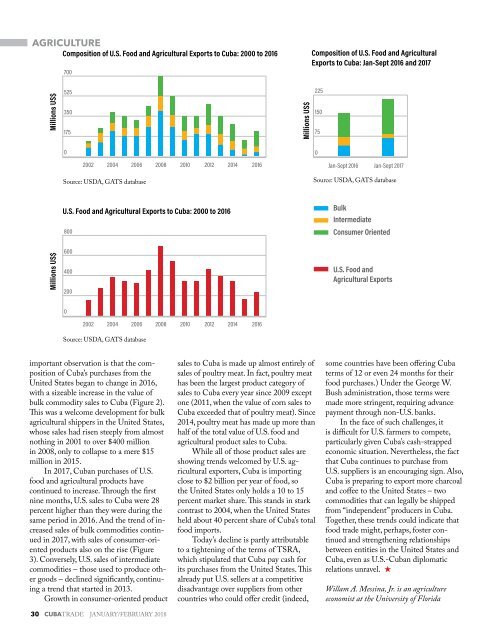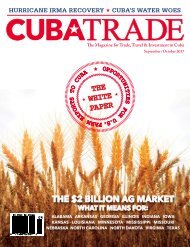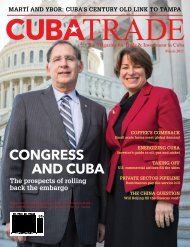Create successful ePaper yourself
Turn your PDF publications into a flip-book with our unique Google optimized e-Paper software.
AGRICULTURE<br />
Composition of U.S. Food and Agricultural Exports to Cuba: 2000 to 2016<br />
700<br />
Millions US$<br />
525<br />
350<br />
175<br />
Millions US$<br />
Composition of U.S. Food and Agricultural<br />
Exports to Cuba: Jan-Sept 2016 and 2017<br />
225<br />
150<br />
75<br />
10 commodities contribute<br />
$10 bilIion to Louisiana’s economy.<br />
Imagine what it could do for Cuba.<br />
0<br />
2002<br />
0<br />
2004 2006 2008 2010 2012 2014 2016 Jan-Sept 2016 Jan-Sept 2017<br />
Source: USDA, GATS database<br />
Source: USDA, GATS database<br />
U.S. Food and Agricultural Exports to Cuba: 2000 to 2016<br />
800<br />
Bulk<br />
Intermediate<br />
Consumer Oriented<br />
Millions US$<br />
600<br />
400<br />
200<br />
U.S. Food and<br />
Agricultural Exports<br />
MARINE FISHERIES FORESTRY RICE POULTRY SOYBEANS<br />
0<br />
2002<br />
2004 2006 2008 2010 2012 2014 2016<br />
Source: USDA, GATS database<br />
important observation is that the composition<br />
of Cuba’s purchases from the<br />
United States began to change in 2016,<br />
with a sizeable increase in the value of<br />
bulk commodity sales to Cuba (Figure 2).<br />
This was a welcome development for bulk<br />
agricultural shippers in the United States,<br />
whose sales had risen steeply from almost<br />
nothing in 2001 to over $400 million<br />
in 2008, only to collapse to a mere $15<br />
million in 2015.<br />
In 2017, Cuban purchases of U.S.<br />
food and agricultural products have<br />
continued to increase. Through the first<br />
nine months, U.S. sales to Cuba were 28<br />
percent higher than they were during the<br />
same period in 2016. And the trend of increased<br />
sales of bulk commodities continued<br />
in 2017, with sales of consumer-oriented<br />
products also on the rise (Figure<br />
3). Conversely, U.S. sales of intermediate<br />
commodities – those used to produce other<br />
goods – declined significantly, continuing<br />
a trend that started in 2013.<br />
Growth in consumer-oriented product<br />
30 CUBATRADE JANUARY/FEBRUARY 2018<br />
sales to Cuba is made up almost entirely of<br />
sales of poultry meat. In fact, poultry meat<br />
has been the largest product category of<br />
sales to Cuba every year since 2009 except<br />
one (2011, when the value of corn sales to<br />
Cuba exceeded that of poultry meat). Since<br />
2014, poultry meat has made up more than<br />
half of the total value of U.S. food and<br />
agricultural product sales to Cuba.<br />
While all of those product sales are<br />
showing trends welcomed by U.S. agricultural<br />
exporters, Cuba is importing<br />
close to $2 billion per year of food, so<br />
the United States only holds a 10 to 15<br />
percent market share. This stands in stark<br />
contrast to 2004, when the United States<br />
held about 40 percent share of Cuba’s total<br />
food imports.<br />
Today’s decline is partly attributable<br />
to a tightening of the terms of TSRA,<br />
which stipulated that Cuba pay cash for<br />
its purchases from the United States. This<br />
already put U.S. sellers at a competitive<br />
disadvantage over suppliers from other<br />
countries who could offer credit (indeed,<br />
some countries have been offering Cuba<br />
terms of 12 or even 24 months for their<br />
food purchases.) Under the George W.<br />
Bush administration, those terms were<br />
made more stringent, requiring advance<br />
payment through non-U.S. banks.<br />
In the face of such challenges, it<br />
is difficult for U.S. farmers to compete,<br />
particularly given Cuba’s cash-strapped<br />
economic situation. Nevertheless, the fact<br />
that Cuba continues to purchase from<br />
U.S. suppliers is an encouraging sign. Also,<br />
Cuba is preparing to export more charcoal<br />
and coffee to the United States – two<br />
commodities that can legally be shipped<br />
from “independent” producers in Cuba.<br />
Together, these trends could indicate that<br />
food trade might, perhaps, foster continued<br />
and strengthening relationships<br />
between entities in the United States and<br />
Cuba, even as U.S.-Cuban diplomatic<br />
relations unravel. H<br />
Willam A. Messina, Jr. is an agriculture<br />
economist at the University of Florida<br />
COTTON AQUACULTURE BEEF CATTLE FEED GRAIN HORSES<br />
Louisiana –The Trade Gateway to Cuba<br />
866.927.2476 • ldaf.state.la.us
















